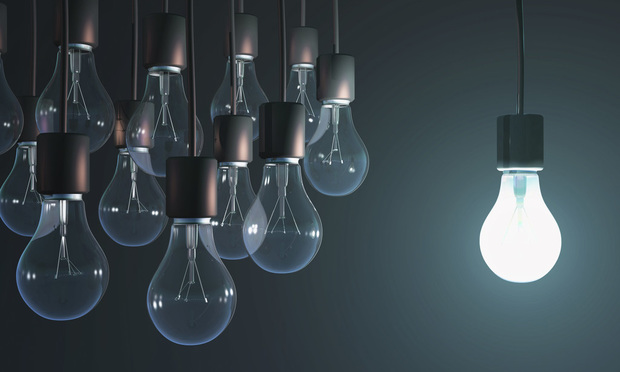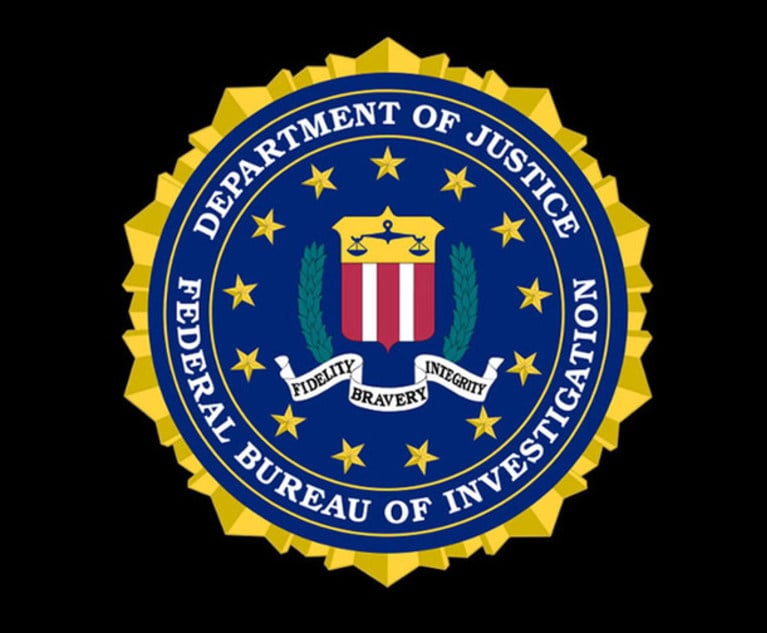Patent Eligibility Now and in the Future
How Congress and the USPTO are working to simplify the analysis of what qualifies as an invention that can be patented.
September 13, 2019 at 10:00 AM
8 minute read
 Photobank – Fotolia
Photobank – Fotolia
Five years have passed since the Supreme Court weighed in on the "abstract idea" exception to eligibility of patent claims under 35 U.S.C. §101. See Alice Corp, Pty. Ltd. v. CLS Bank Int'l, 134 S. Ct. 2347 (2014). Since then, the United States Court of Appeals for the Federal Circuit (CAFC) has issued more than 150 decisions regarding patent eligibility. The United States Patent and Trademark Office (USPTO) has issued several Federal Register notices directing patent examiners and practitioners as to its interpretation of all the post-Alice judicial precedent. Attorneys have spent countless billable hours attempting to interpret and apply this case law and administrative guidance. Now Congress is stirring. In May of this year, Congress released a draft of a bipartisan, bicameral bill that could redefine the kinds of inventions that can be patented. It remains to be seen if this bill or any similar bill, if enacted, will bring clarity to patent eligibility.
The Supreme Court has held that 35 U.S.C. §101, the statute that defines what inventions are eligible for patent, contains an implicit exception for "laws of nature, natural phenomena, and abstract ideas." In Alice, the court found patent claims directed to a computer-implemented scheme for mitigating settlement risk to be an ineligible abstract idea under section 101. The court in Alice set forth a two-part test for determining whether a claim is ineligible: (1) whether the claim is "directed to" a judicial exception, in this case an abstract idea; and (2) whether there is an element or combination of elements in the claim that amount to significantly more than the judicial exception. Id. at 2355. The court did not, however, define the term "abstract idea," leaving that to the CAFC and the USPTO. While the claims in Alice were directed to fundamental economic practices, the CAFC applied the two-part test to several other inventions, including claims directed to software and the machines that implement such software. The result was hundreds of decisions defining what is abstract and what is non-abstract, including some inconsistent decisions defining the same subject matter as both.
The USPTO issued several rounds of guidance as the CAFC issued decisions concerning abstract ideas. Initial USPTO guidance directed patent examiners to compare the claims being examined to those claims already found to be patent eligible or ineligible by the Supreme Court and CAFC. 79 Fed. Reg. §74,618 (Dec. 16, 2014). The USPTO issued several example claims based on court decisions, which patent examiners and practitioners could use to argue for and against patentability. In practice, this lead to an expansion of what was considered to be an ineligible abstract idea, including apparatus claims (e.g., circuits and systems) that included functional limitations (as opposed to structural limitations). Under the second part of the two-part test, patent examiners were directed to ignore claim elements that were well-understood, routine, or conventional activity from being "significantly more" than the abstract idea. In practice, this often resulted in conflation of subject matter eligibility and novelty. For example, a claim would be deemed abstract and ineligible by identifying a single abstract idea and discounting the remaining limitations as being conventional.
In January 2019, however, the USPTO recognized the ineffectiveness of the process and issued revised guidance. 84 Fed. Reg. §50. The revised guidance split part of the test that determines if the claim is directed to an abstract idea into two prongs. For "prong one," the USPTO directs patent examiners to categorize the abstract idea into one of three categories: (1) mathematical concepts; (2) certain methods of organizing human activity (e.g., fundamental economic practices); and (3) mental processes performed in the human mind. For "prong two," the USPTO directs patent examiners to evaluate whether the abstract idea, if present, is integrated into a practical application. The prong-two analysis is similar to analysis of "significantly more" under the second part of the two-part test, but with an important distinction: prong two specifically excludes consideration of whether the additional elements represent well-understood, routine or conventional activity. This effectively removes novelty from the determination of whether a claim is directed to an abstract idea.
In May 2019, United States Senators Tillis, Coons, Collins, Johnson and Stivers released a draft bill that would amend the patent code to overrule the judicially created exceptions to patentability. In particular, the draft bill defines the term "useful" to mean "any invention or discovery that provides specific and practical utility in any field of technology through human intervention." The draft bill also replaces "new and useful" with "useful," which removes the question of novelty from the patent eligibility determination. Comments to the draft state that the provisions of section 101 should be construed to favor eligibility and that "[n]o implicit or other judicially created exceptions to subject matter eligibility, including 'abstract ideas,' 'laws of nature,' or 'natural phenomena,' shall be used to determine patent eligibility under section 101." Thus, the draft bill expressly intends to statutorily overrule Supreme Court and CAFC jurisprudence related to judicial exceptions to subject matter eligibility.
The Senate Judiciary Subcommittee on Intellectual Property held hearings regarding the draft bill in early June of 2019. The subcommittee received testimony from 45 witnesses, some of whom lauded the changes and others of whom were more skeptical. Notably, former USPTO Directors David Kappos and Todd Dickinson, and former CAFC Chief Judges Paul Michel and Randall Raider, called on Congress to pass the legislation to address the uncertainty of the current patent eligibility framework. On the other hand, the American Civil Liberties Union (ACLU) has come out against the draft bill, contending that it would allow for patenting of laws of nature, abstract ideas, and general fields of knowledge. The ex-patent officials and judges pushed back, contending that there are constitutional and statutory bars against patenting such categories.
So where does this get us? The USPTO's current guidance has some similarities to the draft bill, in particular, the removal of novelty from the framework. It should be noted that the courts still apply the two-part test as set forth in Alice, and the USPTO's framework is limited to application against patent applications currently pending in the office. It can be argued that with its current guidance, the USPTO will allow more claims than would be determined patent-eligible by the courts. The courts do not have any prohibition against considering claim elements as representing well-understood, routine or conventional activity and can sometimes conflate the two parts of the test. As a patent prosecutor, however, the USPTO's current guidelines are more favorable than previous frameworks, resulting in more clarity. The draft bill would only improve upon the USPTO's current framework and will prevent any issues related to the slightly different tests being applied currently by the USPTO and the courts.
Patent owners and patent litigators may have a different opinion depending on whether they are asserting patents or defending against broad, abstract claims. Companies and parties defending against patent litigation have been using Alice to invalidate broad and abstract claims being asserted against them. The draft bill does make a concession in this regard, by proposing amendment to 35 U.S.C. §112(f) to change how functional claiming will be considered (which is beyond the scope of this article). In any case, more clarity from a statutory framework will result in spending fewer resources, and less time and effort advancing uncertain patent eligibility arguments, and more toward traditional novelty and obviousness arguments.
The proposed bill would also bring more certainty to innovators. Innovators can focus on prior art against their inventions, rather than guessing whether their inventions are even eligible for patenting under the litany of case law. Finally, the concern that the draft bill would allow for patenting of laws of nature, abstract ideas and general fields of knowledge appears to be unfounded. Congress is unlikely to intend for such categories to be protected. Further, the Supreme Court may still have a say as to how far Congress can legislate in this area through their interpretation of the patent clause in Article I, Section 8, of the United States Constitution. It is unlikely the court would allow Congress to permit patenting of laws of nature or pure abstract ideas, finding a way to prohibit such through the Constitution. With an election year looming, hopefully Congress can pass a bill to bring clarity to patent eligibility.
Robert M. Brush is a partner with Patterson & Sheridan in Shrewsbury. He is an intellectual property attorney specializing in drafting and prosecuting patent applications in the electrical, computer and mechanical arts.
This content has been archived. It is available through our partners, LexisNexis® and Bloomberg Law.
To view this content, please continue to their sites.
Not a Lexis Subscriber?
Subscribe Now
Not a Bloomberg Law Subscriber?
Subscribe Now
NOT FOR REPRINT
© 2025 ALM Global, LLC, All Rights Reserved. Request academic re-use from www.copyright.com. All other uses, submit a request to [email protected]. For more information visit Asset & Logo Licensing.
You Might Like
View All
3rd Circuit Strikes Down NLRB’s Monetary Remedies for Fired Starbucks Workers


As Trafficking, Hate Crimes Rise in NJ, State's Federal Delegation Must Weigh in On New UN Proposal
4 minute read
Trending Stories
Who Got The Work
J. Brugh Lower of Gibbons has entered an appearance for industrial equipment supplier Devco Corporation in a pending trademark infringement lawsuit. The suit, accusing the defendant of selling knock-off Graco products, was filed Dec. 18 in New Jersey District Court by Rivkin Radler on behalf of Graco Inc. and Graco Minnesota. The case, assigned to U.S. District Judge Zahid N. Quraishi, is 3:24-cv-11294, Graco Inc. et al v. Devco Corporation.
Who Got The Work
Rebecca Maller-Stein and Kent A. Yalowitz of Arnold & Porter Kaye Scholer have entered their appearances for Hanaco Venture Capital and its executives, Lior Prosor and David Frankel, in a pending securities lawsuit. The action, filed on Dec. 24 in New York Southern District Court by Zell, Aron & Co. on behalf of Goldeneye Advisors, accuses the defendants of negligently and fraudulently managing the plaintiff's $1 million investment. The case, assigned to U.S. District Judge Vernon S. Broderick, is 1:24-cv-09918, Goldeneye Advisors, LLC v. Hanaco Venture Capital, Ltd. et al.
Who Got The Work
Attorneys from A&O Shearman has stepped in as defense counsel for Toronto-Dominion Bank and other defendants in a pending securities class action. The suit, filed Dec. 11 in New York Southern District Court by Bleichmar Fonti & Auld, accuses the defendants of concealing the bank's 'pervasive' deficiencies in regards to its compliance with the Bank Secrecy Act and the quality of its anti-money laundering controls. The case, assigned to U.S. District Judge Arun Subramanian, is 1:24-cv-09445, Gonzalez v. The Toronto-Dominion Bank et al.
Who Got The Work
Crown Castle International, a Pennsylvania company providing shared communications infrastructure, has turned to Luke D. Wolf of Gordon Rees Scully Mansukhani to fend off a pending breach-of-contract lawsuit. The court action, filed Nov. 25 in Michigan Eastern District Court by Hooper Hathaway PC on behalf of The Town Residences LLC, accuses Crown Castle of failing to transfer approximately $30,000 in utility payments from T-Mobile in breach of a roof-top lease and assignment agreement. The case, assigned to U.S. District Judge Susan K. Declercq, is 2:24-cv-13131, The Town Residences LLC v. T-Mobile US, Inc. et al.
Who Got The Work
Wilfred P. Coronato and Daniel M. Schwartz of McCarter & English have stepped in as defense counsel to Electrolux Home Products Inc. in a pending product liability lawsuit. The court action, filed Nov. 26 in New York Eastern District Court by Poulos Lopiccolo PC and Nagel Rice LLP on behalf of David Stern, alleges that the defendant's refrigerators’ drawers and shelving repeatedly break and fall apart within months after purchase. The case, assigned to U.S. District Judge Joan M. Azrack, is 2:24-cv-08204, Stern v. Electrolux Home Products, Inc.
Featured Firms
Law Offices of Gary Martin Hays & Associates, P.C.
(470) 294-1674
Law Offices of Mark E. Salomone
(857) 444-6468
Smith & Hassler
(713) 739-1250






